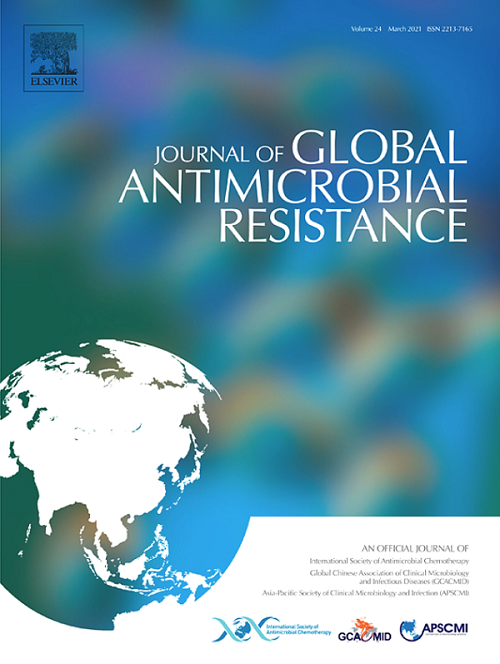Genetic determinants and phenotypic characteristics of heavy metal and biocide tolerance among multidrug-resistant and susceptible Gram-negative bacilli clinical isolates
IF 3.7
3区 医学
Q2 INFECTIOUS DISEASES
引用次数: 0
Abstract
Antimicrobial resistance is a major health care problem as well as a concern for global public health. As a result, the use of nonantibiotic antimicrobials, such as heavy metals and biocides, has increased in a bid to control the spread of antibiotic-resistant bacteria. Consequently, heavy metal tolerance genes (HMTGs) and biocide tolerance genes (BTGs) have been more frequently detected in Gram-negative bacilli. In this study, we searched for acquired HMTGs, BTGs, and antibiotic resistance genes (ARGs) and determined the MICs of common heavy metals and biocides in multidrug-resistant and susceptible Gram-negative bacilli clinical isolates. A high frequency of silA and pcoD genes was mainly detected among Klebsiella spp. and Enterobacter cloacae regardless of their susceptible profile. The merA gene was also found in isolates carrying silA/pcoD genes. ARGs were detected in isolates that harboured silA and/or pcoD genes. BTGs (qacΔE, ydgE, ydgF, mdfA, and emrE) were mostly detected in Klebsiella pneumoniae and E. cloacae isolates regardless of their susceptibility profile, and these isolates often co-harboured HMTGs and/or ARGs. Higher copper sulphate MIC values were obtained under aerobic conditions, regardless of the presence or absence of pcoD and/or silA genes. Nevertheless, in most isolates carrying pcoD/silA, higher copper sulphate MIC values were determined under anaerobic conditions. Regarding AgNO3, no significant differences in MIC values were observed for isolates with or without the silA gene. Our results show a broad distribution of HMTGs, BTGs, and ARGs in bacteria causing health care-associated infections, which could contribute to the co-selection of hospital pathogens resistant to multiple and diverse antimicrobials.
多重耐药和敏感革兰氏阴性杆菌临床分离株重金属和杀菌剂耐受的遗传决定因素和表型特征。
抗菌素耐药性是一个主要的卫生保健问题,也是全球公共卫生关注的问题。在目前的情况下,为了控制耐抗生素细菌的传播,重金属和杀菌剂等非抗生素抗菌剂的使用有所增加。因此,革兰氏阴性杆菌中较多检出重金属耐受基因(HMTG)和杀菌剂耐受基因(BTG)。本研究对革兰氏阴性杆菌临床多重耐药和敏感菌株进行了获得性HMTG、BTG和获得性耐药基因(ARG)的筛选,并测定了常见重金属和杀菌剂的最低抑菌浓度(MIC)。在克雷伯氏菌和阴沟肠杆菌中,silA和pcoD基因的高发频率与它们的易感谱无关。在携带silA-pcoD基因的分离株中也发现了merA基因。在含有silA和/或pcoD基因的分离株中检测到ARG。BTG (qacΔE, ydgE, ydgF, mdfA和emrE)主要在肺炎克雷伯菌和阴沟肠杆菌分离株中检测到,无论其易感谱如何,这些分离株通常同时携带HMTG和/或ARG。在有氧条件下,无论pcoD和/或silA基因是否存在,都能获得较高的CuSO4 MIC值。然而,在大多数携带pcoD/silA的菌株中,厌氧条件下测定的CuSO4 MIC值较高。对于AgNO3,携带或不携带silA基因的分离株的MIC值无显著差异。我们的研究结果显示,HMTG、BTG和ARG在引起医疗保健相关感染的细菌中分布广泛,这可能有助于共同选择对多种抗菌素具有多重耐药的医院病原体。
本文章由计算机程序翻译,如有差异,请以英文原文为准。
求助全文
约1分钟内获得全文
求助全文
来源期刊

Journal of global antimicrobial resistance
INFECTIOUS DISEASES-PHARMACOLOGY & PHARMACY
CiteScore
8.70
自引率
2.20%
发文量
285
审稿时长
34 weeks
期刊介绍:
The Journal of Global Antimicrobial Resistance (JGAR) is a quarterly online journal run by an international Editorial Board that focuses on the global spread of antibiotic-resistant microbes.
JGAR is a dedicated journal for all professionals working in research, health care, the environment and animal infection control, aiming to track the resistance threat worldwide and provides a single voice devoted to antimicrobial resistance (AMR).
Featuring peer-reviewed and up to date research articles, reviews, short notes and hot topics JGAR covers the key topics related to antibacterial, antiviral, antifungal and antiparasitic resistance.
 求助内容:
求助内容: 应助结果提醒方式:
应助结果提醒方式:


